1. INTRODUCTION
The sap is a forest product harvested during the winter and early spring and is an important income source related to forestry policy. A typically harvested species in Korea is Acer pictum var. mono, while subspecies Acer okamotoanum Nakai and Acer pictum var. truncatum are also known as the main sap production strains. In particular, A. okamotoanum Nakai has gained attention since earlier days as potential short-term economic crop due to its unique ginseng scent and relatively high contents of sugar and inorganic components (Kwon et al., 2010). In case of A. okamotoanum Nakai which only grows in Ulleungdo, the main sap collection source had been the natural forest in Ulleungdo, but a demand for artificial afforestation in the inland area for A. okamotoanum Nakai sap production has been increasing recently.
In 2005, Forest Biomaterials Research Center of Korean National Institute of the Forest Science established an artificial forest for the growth of A. okamotoanum Nakai in Gajwa Experimental Forest in the City of Jinju. The purpose was to investigate inland adaptability and growth conditions of A. okamotoanum Nakai (Yoon et al., 2012). Nine years after the plantation, we confirmed that the diameter at breast heightreached 10 cm, which indicates the fitness for sap collection (Lim et al., 2016). Temperature is known to be the most important factor in sap flow (Choi et al., 2010). Jiri Mountain area has reported mid-February with the daily mean temperature of 1.2±1.6°C, the daily minimum temperature of -4.3±1.5°C and the daily maximum temperature of 11.8±1.9°C to be the optimal sap flow period (Choi et al., 2010).
However, the perforation period for the optimal sap production varies by region as each region has different average temperature and diurnal temperature variation. The study site of this research has also been monitoring the sap flow and composition each year since 2014 to predict the perforation period for effective production of the appropriate volume of sap. The result to date based on the average annual temperature of the past 30 years in Jinju area of Gyeongsangnam-do Province suggests the critical date for sap tapping to have the daily mean temperature of 3.42°C, the daily minimum temperature of -2.14°C and the daily maximum temperature of 10.60°C, and for the tapping period to last from the end of January to mid-February (Kim et al., 2017). In this study, we collected sap by perforating artificially planted A. okamotoanum Nakai in Jinju area in two phases with an interval of 30 days.
The purpose of this study was to investigate the sap flow based on perforation period and to analyze sap composition in effort to utilize the results as a base line data for inland A. okamotoanum Nakai sap research.
2. MATERIALS and METHODS
The research site for this study is a plantation in Gajwa Experimental Forest, part of National Institute of the Forest Science’s Forest Biomaterials Research Center located in Jinju, Gyeongsangnam-do Province. The plantation is 112 m above sea level and is on the northeastern slope of 32 degrees. Each phase used five saplings (diameter at breast height10-20 cm) of A. okamotoanum Nakai planted in 2005 for the sap collection (Table 1).
| Location | GPS | Altitude (m) | Slope (°) | Aspect | Tree no. /ha |
|---|---|---|---|---|---|
| Gyeongnam Jinju | N35°09′ E128°05′ | 112 | 32 | E | 1,333 |
Tree samples consisted of saplings (diameter at breast height 10-20 cm), and we used five samples for the collection in phase 1 and phase 2 respectively. For the perforation, we used 8 mm drill at a height of 1 m from the soil surface in accordance with sap collection protocol of Korea Forest Services. Up to two perforations are allowed, but we decided on one perforation using 8 mm hose for this study. Phase 1 collection was conducted from January 10, 2019 to February 9, 2019. Upon completion of measuring the collected sap in phase 1, collection for phase 2 followed from February 12, 2019 until February 22, 2019. The perforation began at 11:00 a.m., and we recorded the exact sap flow amount every 24 hours using measuring cylinder. The daily temperature and relative humidity were recorded with micrometeorological measuring equipment (WH-2300S, CHANJU TECH Co., China). Fig. 1.
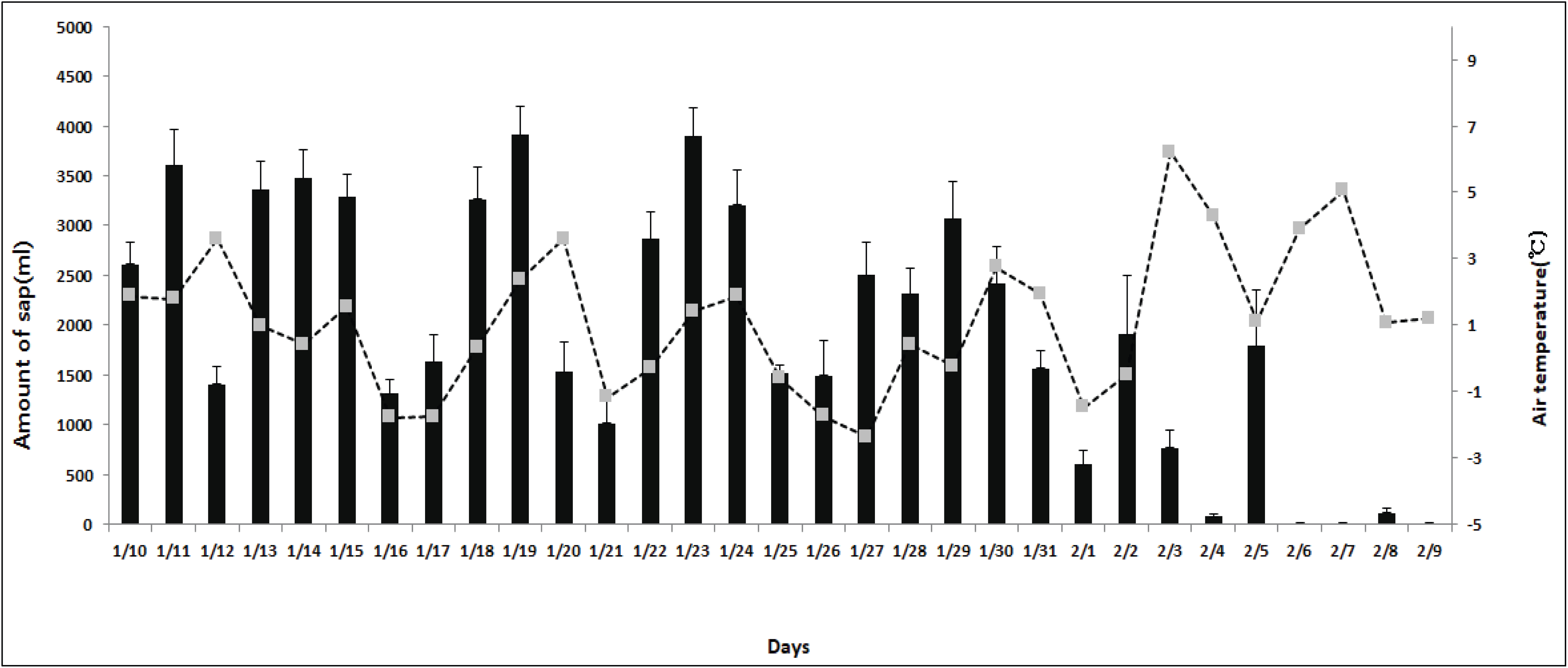
The sap collected from each sample was used for the analyses of contents of sugar and inorganic elements every 24 hours. Immediately after measuring the sap flow, we filtered the sap through a 0.45-μm permeable membrane filter and diluted it to 1:100 concentration to analyze the sugar content using Bio-LC (Dionex, 2000). Glucose (sigma), fructose (sigma) and sucrose (sigma) were used to prepare the calibration lines for quantitative analysis. We used MA1 (250 x 4 mm, Dionex, Palo Alto, CA, USA) for column, an amperometry detector (HP 1100, Hewlett Packard, USA) for detection and sodium hydroxide 617 mmol as the eluent solution. The analysis was performed at 40°C with the flow rate of 0.4 mL/min. We injected 10 μL of samples and performed two repetitions of the analysis.
Inorganic elements were also analyzed every 24 hours using inductively coupled plasma mass spectrometer (ICP-MS, ANALYTIKJENA, Germany) after filtering the collected sap through a 0.45-μm permeable membrane filter and diluting it to 1:200 concentration. (Table 2).
| Textural class | Soil texture (%) | ||
|---|---|---|---|
| Sand | Silt | Clay | |
| Clay loam | 36.00 | 36.00 | 28.00 |
3. RESULTS and DISCUSSION
The forest stand of A. okamotoanum Nakai at the study site was 1,333 per hectare. Among these, we selected 10 saplings as samples for sap flow investigation. As of 2019, samples measured an average plant life of 14 year, an average height of 12.8 m, an average diameter at breast height of 15.84 cm, tree volume of 0.056 m3, an average trunk of 2.77 m and an average crown of 7.09 m (Table 3).
| Hz(m) | DBH(cm) | CL(m) | WC(m) | Age(yr) |
|---|---|---|---|---|
| 12.8 ± 1.40 | 15.84 ± 2.20 | 2.77 ± 0.72 | 7.09 ± 0.64 | 14.0 ± 0.0 |
The total duration and amount of sap flow differed for the sap collected in phase 1 and phase 2. The sap flow lasted for 32 days (January 10 - February 9) in phase 1, compared to 11 days (February 12 - 22) in phase 2. The total sap flow amount measured at 60.59 L in phase 1 and 13.38 L in phase 2. Based on Korea Forest Service’s current recommenced yield of 1,250 mL/day for saplings (Lim et al., 2016), the sap flow in phase 2 was markedly low.
This may be due to the difference in each individual sample, but it is believed to be caused by the temperature, which is known as the most crucial factor (Choi et al., 2012). The temperature data from the study site showed that the average daily temperature of the total sap flow duration in phase 1 was similar to the previously recorded (Choi et al., 2010) optimal average daily temperature (1.2±1.6°C) at 1.16±2.15°C, while that of phase 2 was 2.55±1.30°C. When phase 1 was divided into periods of 10 days, the sap flow amount was 29.4 L from January 10th to 20th, 25 L from January 21st to 31st and 5.3 L from February 1st to 10th, indicating 90% of the total sap flow produced in January. In particular, a previous research confirmed a sharp decrease in sap flow when the average daily temperature was 3.42°C or higher (Kim et al., 2017), and we believe that the sap flow in February rapidly decreased in comparison to January as the average daily temperature rose over the critical point beginning February 3rd in 2019.
The average sap flow of January in phase 1 was 2.5 L, and sap flow on 12, 16, 17, 20, 21, 25, 26 and 31 of January fell short of the average quantity. Such phenomena should be reviewed in relation to diurnal temperature variation. The sap is known to flow between the range of night temperature below zero and daytime temperature above zero. A pervious study reported that the sap flows the most when the lowest temperature is -4.3±1.5°C and the highest temperature is 11.8±1.9°C. In this study, we believe that the sap flow was low, because the maximum temperature on days of below-average sap flow was relatively high at a range of 4.3°C to 7.6°C (Fig. 2), while the diurnal temperature variation was small. (Table 4).
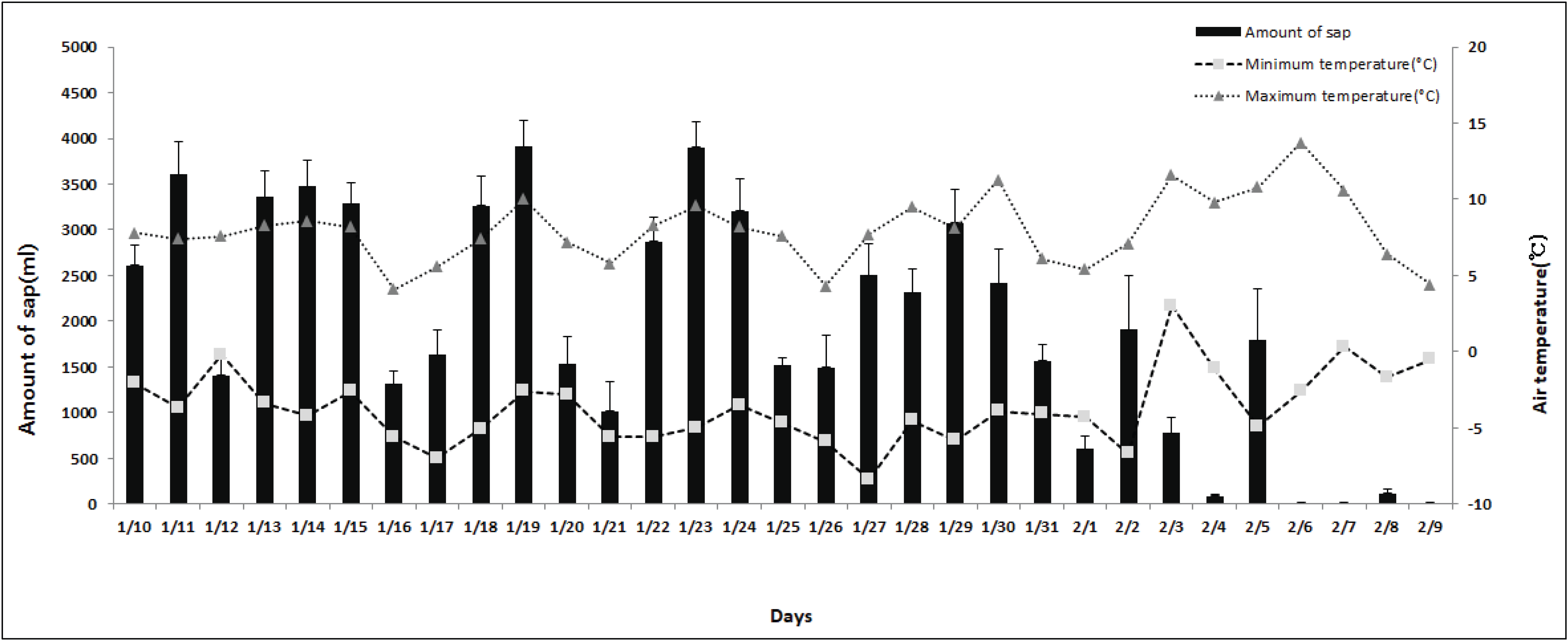
The effects of diurnal temperature variation were evident in the results of phase 2 collection. The daily average sap flow of 1.33 L was around half of phase 1, and sap flow did not meet the average value on 14, 15, 16, 20, 21 and 22 of February (Fig. 3). The temperature on most days of February fell within the aforementioned optimal maximum temperature, but the sap flow is believed to have reduced due to the high range of the minimum temperature between -2.5°C and -0.4°C. As a result, we were able to confirm the importance of the daily mean temperature and the diurnal temperature variation, and found the minimum temperature to be -4.3°C±1.77°C and the maximum temperature to be 8.30±0.80°C on days with high sap flow.
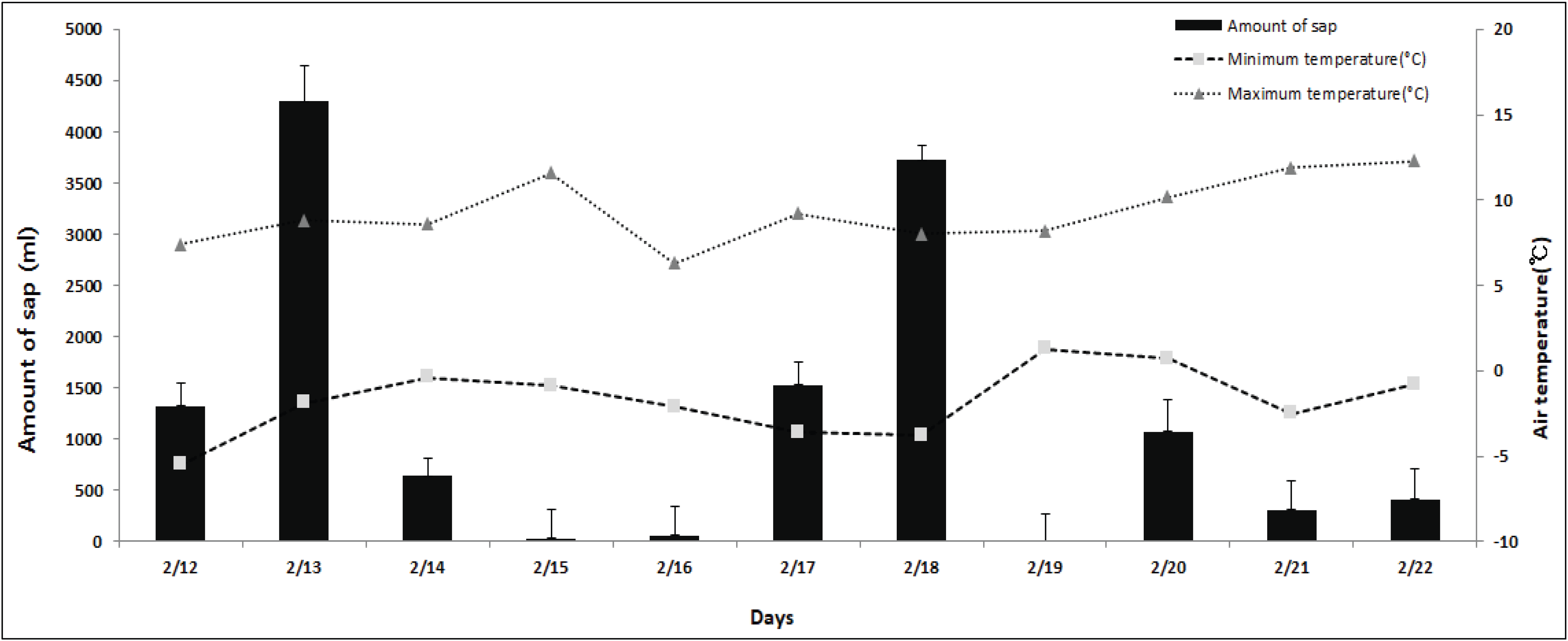
Sugar and inorganic component analyses (Bio-LC) immediately followed the sap collection every day. The main sugar content of sap is glucose, fructose and sucrose, while the sucrose is known to be the main determinant of sugar content. Analysis of the collected sap showed the sucrose content was the highest among the three, followed by glucose and fructose. Although there are not many sugar content analyses of A. okamotoanum Nakai in Korea, some published results report that only sucrose is found in the sap produced in Ulleungdo region (Moon et al., 2004). It is probable these differences could be caused by varying methods of analyses than by characteristics of production sites. (Table 5).
Sucrose content change was analyzed to be 2.5-0.8% depending on the sap collection date (Figs. 4 and 5). We observed relatively high sugar content especially in the beginning, and the concentration decreased towards the latter half of the collection period. This was similar to a report from 2014, which measured the sap collected from the same study site with a saccharometer and found initial increase in sucrose content up to 2.3% and decrease to 1.2% at the end (Kim et al., 2017). The sucrose concentration measured in our study was lower than a study that showed a maximum of 3% sucrose concentration, but the range of A. okamotoanum Nakai sugar content was similar (Moon et al., 2004). The longer the collection period, the lower the sucrose concentration, but there was no correlation between the sucrose concentration and daily sap flow.
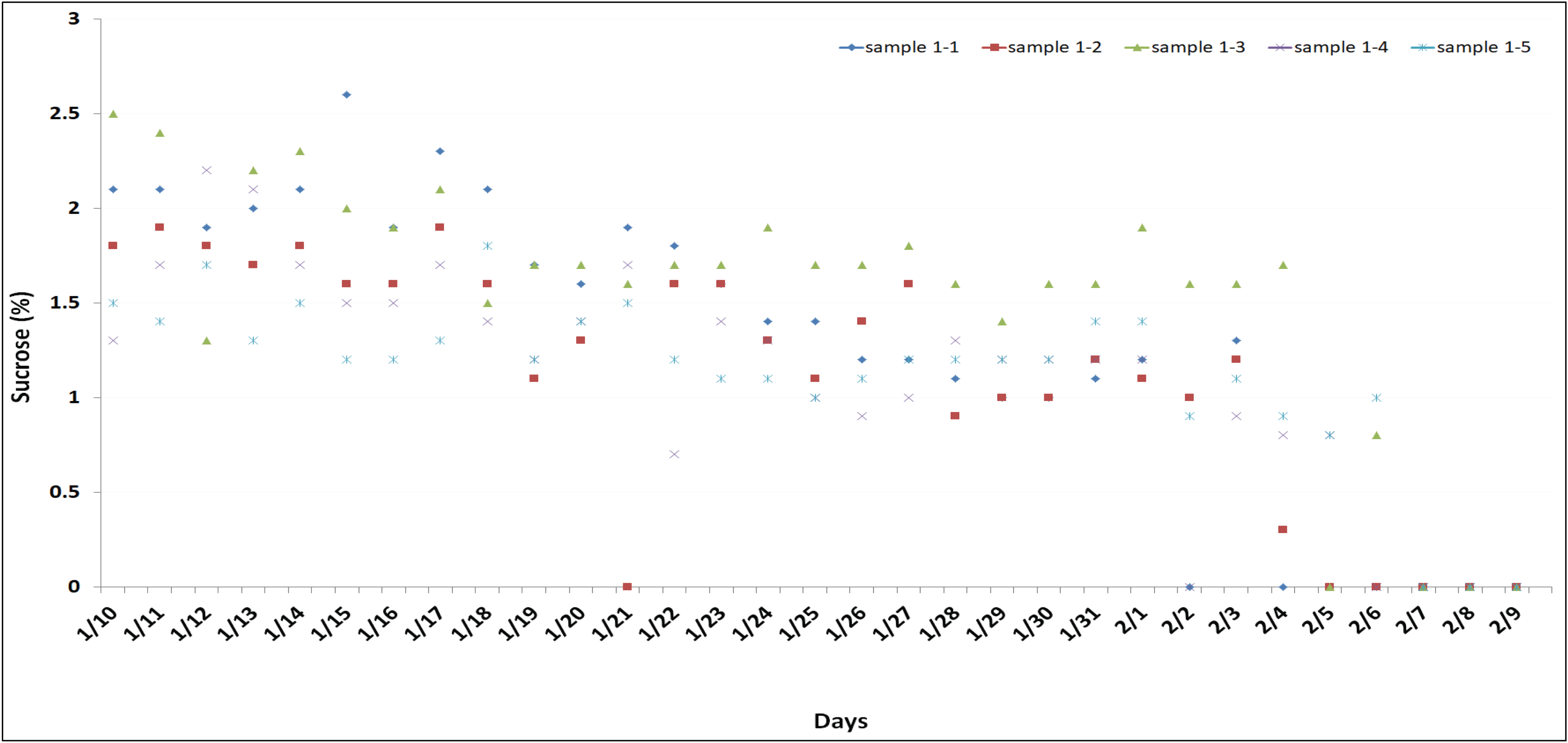
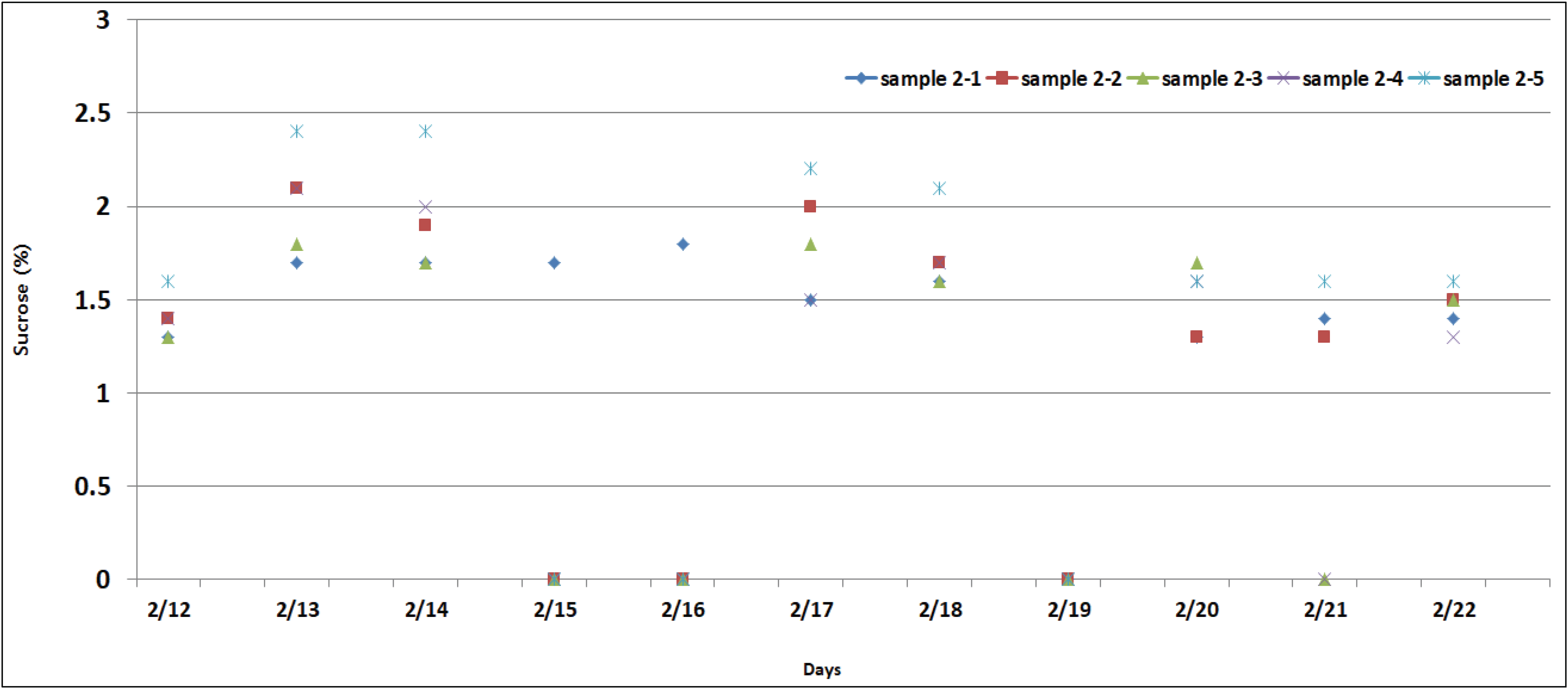
The sucrose concentration in phase 2 was also measured at its highest at 2.4% in the early days (February 13) and continued to decrease towards the end (February 22, Fig. 5). The decrease in sucrose concentration over time was also evident in sap collected in phase 2. as a result, there was a notable difference in sap flow between the two collection phases in this study, but the sucrose concentration and the change in concentration based on the collection period showed a similar trend.
Analysis of eight inorganic elements in the sap showed the highest content of calcium, potassium, magnesium and phosphorus in order, and recorded relatively low levels of sodium, aluminium, manganese, iron and zinc. Previous research also reports that calcium and potassium comprise 81% of inorganic elements in saps (Kim et al., 2010). The potassium concentration in the sap collected in phase 1 was 46.65-79.11 mg/kg, and the content decreased over time. The potassium concentration from phase 2 samples was 60.80-78.12 mg/kg, similar to the case in phase 1. Calcium (25.27-48.14 mg/kg) and phosphorus (7.06-8.59 mg/kg) concentration ranges of samples from phase 1 and 2 were also similar. The Calcium concentration was notably lower than the sap calcium concentration (548 mg/kg) of A. okamotoanum Nakai from Ulleungdo reported by Moon (2004). In case of magnesium, the sap from phase 1 had higher concentration of 17.03-27.25 mg/kg than the same from phase 2 at 10.84-19.99 mg/kg.
4. CONCLUSION
We analyzed the sap flow and composition of artificially planted A. okamotoanum Nakai in Jinju region of Gyeongsangnam-do Province. After collecting the samples in two phases with an interval of 30 days, we observed significant difference in total sap flow amount between the two phases and confirmed that result is closely connected to diurnal temperature variation and temperature conditions. No changes in sugar content or concentration of inorganic elements over collection time were identified. Although the sugar and inorganic element content of A. okamotoanum Nakai in the research site was reported to be lower than the previously reported A. okamotoanum Nakai from Ulleungdo, it is believed to be caused by the characteristics of soil and climate in each region.
Future studies will follow to discover useful and functional ingredients in A. okamotoanum Nakai sap other than sugar and inorganic elements. The results of this study are to be used as base line data for sap resource collection and production.








